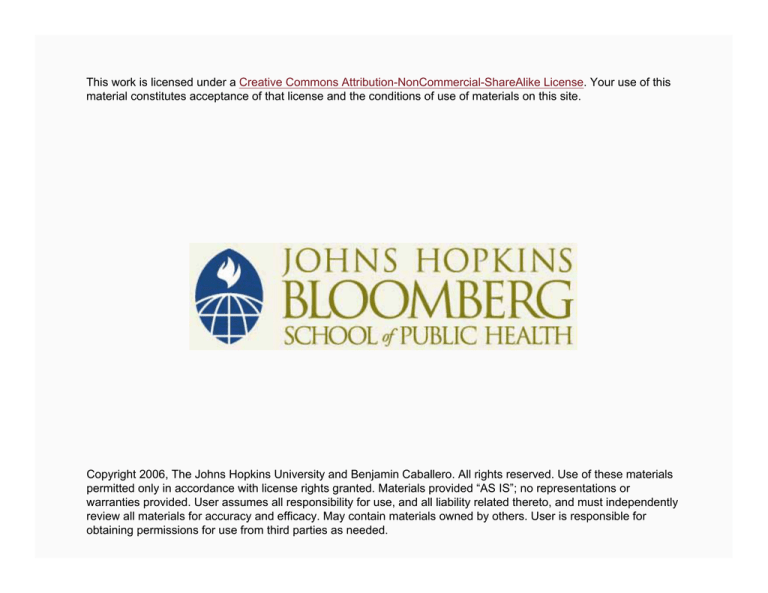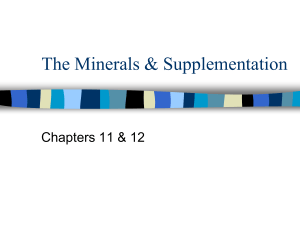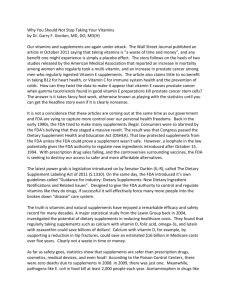
This work is licensed under a Creative Commons Attribution-NonCommercial-ShareAlike License. Your use of this
material constitutes acceptance of that license and the conditions of use of materials on this site.
Copyright 2006, The Johns Hopkins University and Benjamin Caballero. All rights reserved. Use of these materials
permitted only in accordance with license rights granted. Materials provided “AS IS”; no representations or
warranties provided. User assumes all responsibility for use, and all liability related thereto, and must independently
review all materials for accuracy and efficacy. May contain materials owned by others. User is responsible for
obtaining permissions for use from third parties as needed.
Dietary Supplements
Benjamin Caballero, MD, PhD
Johns Hopkins University
Section A
Overview of Dietary Supplements
Dietary Supplements: Definition
Products (other than tobacco) intended to supplement the
diet that bears or contains one or more of the following
dietary ingredients: vitamins, minerals, amino acids, herbs or
other botanical
4
Dietary Supplements: Definition
OR
A dietary substance that supplements the diet by increasing
the total dietary intake
5
Dietary Supplements: Definition
OR
A concentrate, metabolite, constituent, extract, or
combination of any ingredient described above
AND
Intended for ingestion in the form of a capsule, powder,
softgel, or gelcap, and not represented as a conventional food
or as a sole item of a meal or the diet
6
Regulation of Dietary Supplements
Until 1994, dietary supplements were under the regulatory
authority of the FDA (Federal Food, Drug, and Cosmetic Act of
1958—FD&C Act)
In 1994, the Dietary Supplements Health and Education Act
(DSHEA) removed FDA’s authority by excluding dietary
supplements from the FD&C Act
7
Regulation of Dietary Supplements
As a result of these provisions, dietary ingredients used in
dietary supplements are no longer subject to the pre-market
safety evaluations required of other new food ingredients (or
of new uses of old food ingredients)
8
Approval of New Supplements
Manufacturers must notify FDA at least 75 days before
marketing products containing new dietary ingredients,
declaring that a dietary supplement containing the new
dietary ingredient "will reasonably be expected to be safe"
9
Safety and Efficacy Data
There is no provision under any law or regulation that the
FDA enforces that requires companies to disclose the
information they have about the safety or purported benefits
of their dietary supplement products
10
Post-Market Monitoring
Manufacturers and distributors of dietary supplements are
not required by law to record, investigate, or forward to the
FDA any reports they receive of injuries or illnesses that may
be related to the use of their products
11
Post-Market Monitoring
After the product is marketed, FDA must show that a dietary
supplement is "unsafe," before it can take action to restrict,
use, or remove the product from the marketplace
12
The Three Types of Claims
Health claims
− “Prevents acne”
Nutrient content claims
− “Reduced fat”
− “Low cholesterol”
− “Rich in fiber”
Structure/function claims
− “Helps keep a healthy, silky skin”
13
Health Claims
FDA approval required
Based on FDA’s scientific review
OR
“Authoritative statement” from a U.S. government body or
the National Academy of Sciences
Subject to continuing advances in scientific knowledge
14
Approved Health Claims—1
High-folic acid diet (0.4mg/d) prevents neural tube defects
Calcium-rich diets reduce risk of osteoporosis
Diets rich in high-fiber products reduce risk of some forms of
cancer
Low-cholesterol, low-saturated fat diets reduce risk of CVD
15
Approved Health Claims—2
Low-sodium diets reduce the risk of high blood pressure
Low-fat diets reduce risk of some types of cancer
Fruits, vegetables, and grains that contain fiber reduce risk of
CVD
Soy protein and risk of coronary heart disease
Plant sterol/stanol esters and risk of coronary heart disease
Potassium and the risk of high blood pressure and stroke
Dietary sugars and dental caries
16
Nutrient Content Claims
Regulated by FDA
Must provide product composition data
Subject to quality monitoring
17
Examples of Nutrient Content Claims
CLAIM
REQUIREMENT
Calorie-free
<5 kcal
Light (lite)
30% less calories
Reduced fat
25% less fat
High-fiber
At least 5g
Good source of . . . 10–19% of DV
Rich in . . .
20% or more of DV
18
Structure/Function Claims
Not regulated by FDA
No data on efficacy required
Must include two disclaimers
− 1. Not approved by FDA
− 2. Not intended to diagnose, prevent, or treat a disease
19
Section B
Mechanisms of Action of Supplemental Nutrients
Nutrient Metabolism
21
Consuming Higher Amounts of Dietary Constituents
The “push” principle
− Increasing intake of a substrate will promote the
synthesis or activity of its product
The “pull” principle
− An increased synthetic rate of a product will increase the
demand for its substrate
22
Fate of Excess Vitamin Intake
Preferentially
Excreted: C, B1, B2, K, Niacin
Preferentially
Stored: A, B6, B12, D, E
23
Ca Intake and Bone Density
Adapted from: Weaver, AJCN (2000)
24
Vitamin E Trials: Some Examples
Inverse association between intake level and CHD risk (Rimm,
1993; Stampfer, 1993; Kushi, 1996)
ATBC trial
− No effect on lung cancer, 50% excess mortality from
stroke in the supplemented group (Rapola, 1997)
25
Example of Scientific Rationale for Supplementation: Vitamin E
Food and Nutrition Board, NAS (2000)
− There are insufficient data on which to base a recommendation
for supplemental vitamin A to prevent heart disease for the
general population
− Data regarding the protective effects of supplements against
cancer are not as yet available
26
Section C
Dietary Supplements and Physical Performance
“Pull”: Supplements and Physical Performance
Sales of the “sports” supplement CREATINE reached $100
million in 1997, $250 million in 1998, and over $400 million in
2000 (est.)
28
Skeletal Muscle Metabolism
29
Supplements in Sports
There is no evidence that athletes need more vitamins and
minerals than healthy individuals
Protein needs may increase for muscle building or repair
However, this increase is within the range of usual protein
intake in developed countries (~150% of RDA)
30
Supplements in Sports
Because athletes usually require higher than usual energy
intake, fulfilling this need from healthy foods will provide
higher micronutrient intakes
31
Supplements in Sports
Athletes who restrict their energy intake to comply with
professional weight restrictions (wrestling, ballet, etc.) may
risk having insufficient micronutrient intake
32
Creatine
Dietary creatine is derived almost exclusively from red meat
and fish
Supplemental creatine (monohydrate) increases muscle
creatine levels in most but not all people
Excess creatine is rapidly excreted in the urine as
phosphocreatine
33
Creatine
Inconclusive evidence suggests that creatine may improve
performance in repeated bouts of maximal exercise separated
by periods of rest, in individuals 18–35 years of age
No effects on single-bout anaerobic or submaximal aerobic
exercises or in older individuals
Notes Available
34
Possible Adverse Effects of Supplements
Toxicity
− Pro-oxidant role of vitamin E, iron
Nutrient-nutrient interactions
− Inhibition of nutrient absorption
Behavioral
− False belief that taking supplements will make up for
unhealthy lifestyle (sedentary, smoking, etc.)
35
Risks of Supplement Use
Allergic reactions
Competitive inhibition of absorption of other nutrients
Drug-nutrient interactions
Long-term effects
36
Functional Foods
Food modified to enhance health or address a specific dietrelated risk
FDA permits health claims if substantiated by scientific
evidence
37
Examples
Orange juice fortified with calcium
Modified oils (high pro-vitamin A)
Soy-enriched products
High-fiber cereals
38
Supplements vs. Healthy Diet and Lifestyle
Example—Osteoporosis
Calcium, vitamins D, K supplements
OR
Regular exercise outdoors to promote bone health and
enhance endogenous vitamin D synthesis
Fresh fruits and vegetables to provide vitamin K
39
Indications for Nutritional Supplements
When dietary practices put (healthy) individuals at risk of
having low micronutrient intake
− Vegetarian
− Macrobiotic
− Other restricted diets
40
Indications for Nutritional Supplements
When unlikely that a “regular” diet will provide the RDA for a
given nutrient
− Pregnancy
− Lactation
− Breast-fed infants
− Impaired absorption—GI disorders, bariatric surgery,
elderly
− Persistent anorexia
Copyright 2005, Benjamin Caballero and The Johns Hopkins University. All rights reserved. Use of these materials permitted
only in accordance with license rights granted. Materials provided “AS IS”; no representations or warranties provided. User
assumes all responsibility for use, and all liability related thereto, and must independently review all materials for accuracy
and efficacy. May contain materials owned by others. User is responsible for obtaining permissions for use from third parties
as needed.
41




